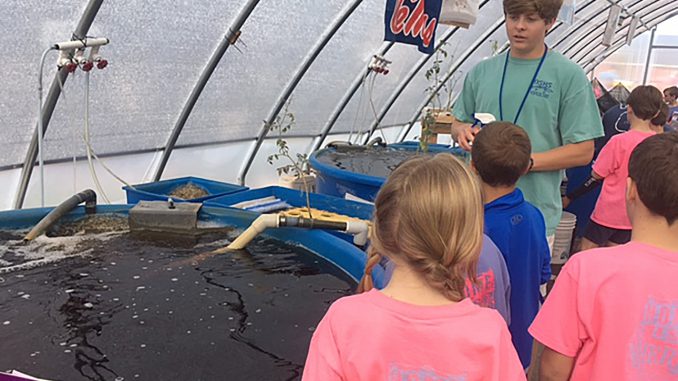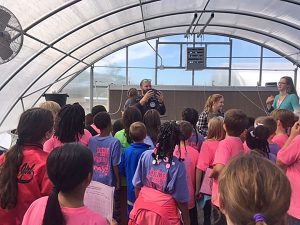
By Karleigh Kimbrell
Connections Magazine
In classrooms across Mississippi, teachers are collaborating to bring together students, but few collaborations feature a brother-sister team. In Ocean Springs, high school CTE students and fourth graders are learning about and developing their own aquaculture systems thanks to a unique, collaborative learning experience created by aquaculture instructor Bryan Butler and his sister, elementary education teacher Ashley Butler-Chennault.
Fishing for New Experiences
Now in its third year, the aquaculture pathway at Ocean Springs High School gives high school students access to the aquaculture infrastructure and devices needed to raise fish in a manmade environment. Butler’s CTE students learn facets of traditional agriculture along with aquaculture techniques, and they hydroponically grow vegetables and raise different species of fish in their on-site tanks.
Shortly after the pathway opened at the high school, Butler began talking to his sister about partnering with her fourth-grade class.
Last year, the fourth graders became familiar with the everyday routine of caring for the plants, fish, and tanks at the high school, and they have now developed their own aquaculture system on their school’s campus to mimic the larger system the CTE program is running. High school CTE students help the fourth graders test the water and ensure pH and nitrates are at their proper levels, and over this year, the younger students raised their own baby catfish in their tank; this project followed the elementary students as they continued to monitor the growth of the fish as they moved to larger tanks. To complete the partnership’s crossover in raising the fish, elementary students chart and log their plant and fish growth in the same laboratory log books used by the high school students.
Planting the Traditional
As part of the traditional agriculture portion of the partnership’s studies, the elementary students added vegetable plants in the outdoor gardens at the upper elementary school. The fourth graders originally potted plants with CTE students at their center, but they took them back to their own campus to monitor the plants’ growth. The elementary students also have their own greenhouse for growing plants throughout the year.
“Plants are grown in the greenhouse or in several raised gardens we have throughout the upper elementary,” Butler said. “That paves the way for all students in the school to enjoy the vegetables and see how they grow.”
This year the students worked diligently with their plants and fish. The elementary students cared for their garden plants and the young fish that they are able to raise within their classroom, while the high school aquaculture students continued their more advanced work on yearly projects of aquaponics systems that include tomatoes, cabbage, carrots, and lettuce. Students also added striped bass and tilapia as their beneficial species to the plants, as these fish serve to feed the plants nutrients. The students worked to make sure the fish are growing to a healthy, large size because the larger the fish, the more fertilizer they produce for the plants.
“My favorite part of our aquaculture program is the planting. It is fun picking your own seeds and watching them grow in our greenhouse. I like how our seeds are planted and fertilized at the high school, but end up growing here at OSUE,” said Christian Reynolds a student at OSUE. “I also enjoy feeding the fish in the big aquaculture tanks when we visit the high school.”
The Long-Term Product
Butler and Butler-Chennault agree they are both motivated by their desire for students to get the best educational experience available to them.
It allows students to explore the natural resources around them and to develop an interest that may impact their decision to stay on the Gulf Coast, which is known for its thriving wildlife and fisheries, should they decide to work in aquaculture sciences. This partnership’s projects aim to encourage students to learn about the area in which they live in hopes to secure a certain future for this industry. As the only CTE pathway like this in the state, Butler believes these students are at an advantage because they have access to this program and to the natural resources, and these teachers hope to continue to enhance and utilize this advantage as much as they can.
Both siblings agree that this collaborative approach to teaching and learning the subject matter has been beneficial for all involved.
When asked to highlight the merits, Butler-Chennault said, “One of our main focuses with this program is engaging younger students in aquaculture and to continue to produce knowledgeable, educated employees for the industry. This project does just that. It is rare that students at an elementary level are given the opportunity for these kinds of hands-on experiences, and it is rare to see a group of high school students and elementary students working so closely together and benefitting from it so greatly. The exposure to the industry the elementary children are receiving is priceless; the experience the high school students are getting is just as invaluable.”
Butler agreed with his sister and said, “The biggest benefit by far for both groups is the interaction between the younger students and the older students. The older students love being leaders in the program and enjoy sharing all that they have learned. The younger students get an eye-opening opportunity to learn the basics of aquaculture and aquaponics. Our hope is to recruit the younger students into the OSHS aquaculture program in the future.”
The future of the aquaculture industry in Mississippi should certainly benefit from the products of this partnership between sibling teachers.
